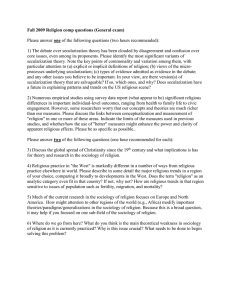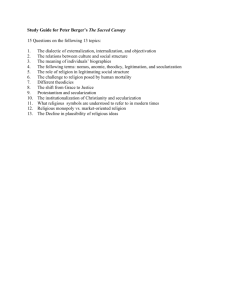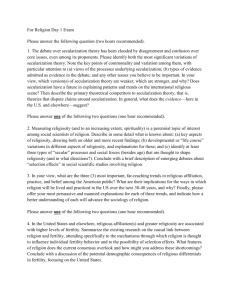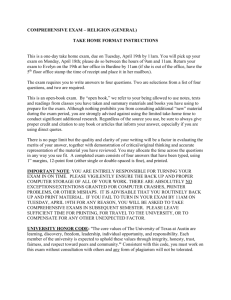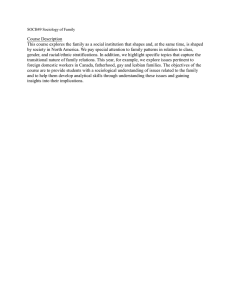Sociology of Religion General Exam:
advertisement
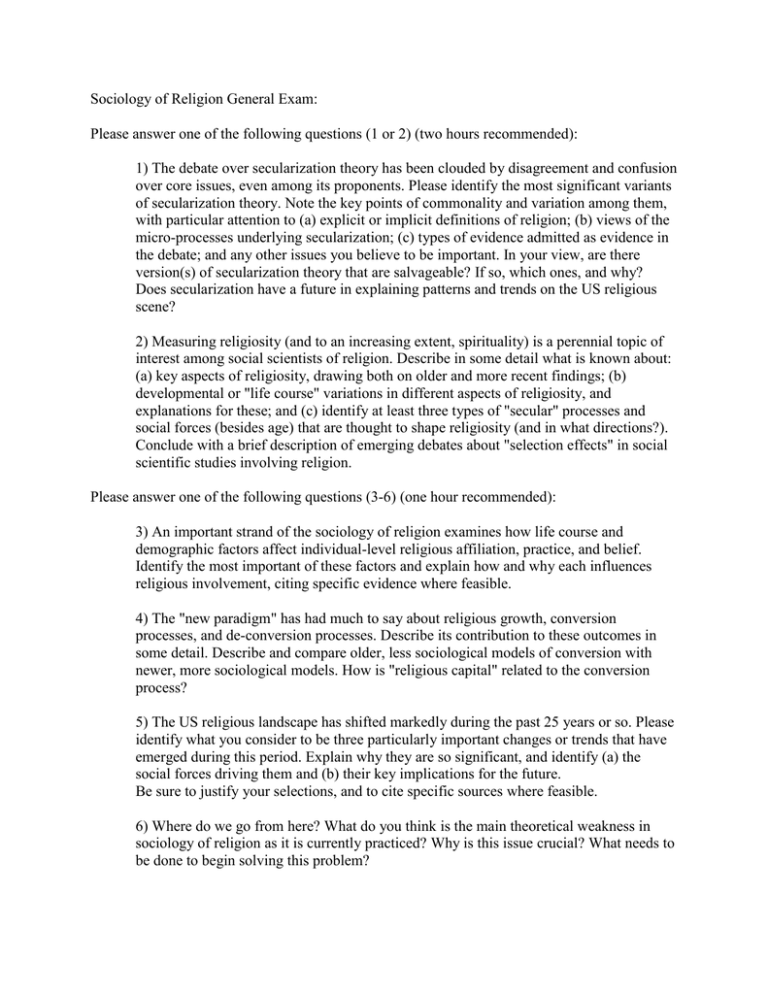
Sociology of Religion General Exam: Please answer one of the following questions (1 or 2) (two hours recommended): 1) The debate over secularization theory has been clouded by disagreement and confusion over core issues, even among its proponents. Please identify the most significant variants of secularization theory. Note the key points of commonality and variation among them, with particular attention to (a) explicit or implicit definitions of religion; (b) views of the micro-processes underlying secularization; (c) types of evidence admitted as evidence in the debate; and any other issues you believe to be important. In your view, are there version(s) of secularization theory that are salvageable? If so, which ones, and why? Does secularization have a future in explaining patterns and trends on the US religious scene? 2) Measuring religiosity (and to an increasing extent, spirituality) is a perennial topic of interest among social scientists of religion. Describe in some detail what is known about: (a) key aspects of religiosity, drawing both on older and more recent findings; (b) developmental or "life course" variations in different aspects of religiosity, and explanations for these; and (c) identify at least three types of "secular" processes and social forces (besides age) that are thought to shape religiosity (and in what directions?). Conclude with a brief description of emerging debates about "selection effects" in social scientific studies involving religion. Please answer one of the following questions (3-6) (one hour recommended): 3) An important strand of the sociology of religion examines how life course and demographic factors affect individual-level religious affiliation, practice, and belief. Identify the most important of these factors and explain how and why each influences religious involvement, citing specific evidence where feasible. 4) The "new paradigm" has had much to say about religious growth, conversion processes, and de-conversion processes. Describe its contribution to these outcomes in some detail. Describe and compare older, less sociological models of conversion with newer, more sociological models. How is "religious capital" related to the conversion process? 5) The US religious landscape has shifted markedly during the past 25 years or so. Please identify what you consider to be three particularly important changes or trends that have emerged during this period. Explain why they are so significant, and identify (a) the social forces driving them and (b) their key implications for the future. Be sure to justify your selections, and to cite specific sources where feasible. 6) Where do we go from here? What do you think is the main theoretical weakness in sociology of religion as it is currently practiced? Why is this issue crucial? What needs to be done to begin solving this problem? Please answer one of the following questions (7-8) (one hour recommended): 7) Most sociology of religion focuses on Europe and North America. Much of this research also focuses on the dominant groups in these areas of the world (i.e., people of European ancestry). How does research about racial and ethnic minorities in these regions challenge/inform dominant theories within the sociology of religion? Because this is a broad question, pick one area (other than health) and discuss the theoretical contribution greater familiarity with research about racial and ethnic minorities would bring. 8) A long tradition of work focuses on African American religious distinctiveness. Please identify the major contributions to our understanding of the Black Church and African American religious life. Describe the key racial differences in individual-level religious affiliation, practice, and belief in the contemporary US. Then summarize what is known about the distinctive role of religion among African Americans with respect to its influence in one of the following domains: health and well-being, politics and social movements, or family and youth.
